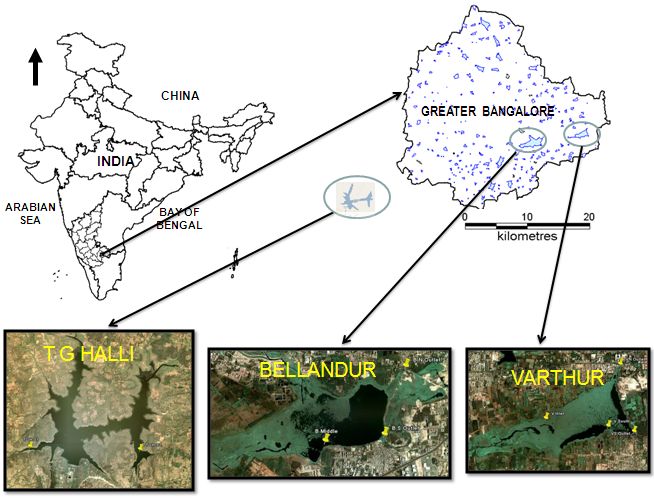Centre for infrastructure, Sustainable Transportation and Urban Planning [CiSTUP], Indian Institute of Science, Bangalore 560 012, India
E-mail: durgamadhab@ces.iisc.ac.in, supriya@ces.iisc.ac.in, chanakya@cst.iisc.ac.in, cestvr@ces.iisc.ac.in Materilas and Methods Study Area: The study areas comprise of three main water bodies of Greater Bangalore (Figure 1), the TG Halli reservoir which was used for supply of drinking water to the western part of Bangalore (35 MLD). T.G. halli situated at the peripheral region approx. 25 km from Bangalore city on the way to Magadi [Figure1 a)]. The water from reservoir is pumped to water treatment plant located near the reservoir which is one of the main sources that provide drinking water to the residents of Bangalore city. The main source of water to the reservoir is the river Arkavati and domestic discharge from North part of Bangalore including Peenya, Dasarahalli and Jalahalli connections. Bellandur Lake is the largest lake in the city situated at the south part of Bangalore. The Lake being 130 years old and spreads across an area of 365 ha and is located near the Bellandur village towards the south of Bangalore [Figure1 b)]. Sewage from residential areas near the Bangalore international airport is directly allowed into the lake through the main drain. Dense weeds have occupied a major portion of the lake, thus affecting the photosynthesis process by obstructing penetration of sunlight. Objectionable froth has been developed at the overflow region (at the outflows). Varthur Lake, is the second largest fresh water body in Bangalore built by the Ganga Kings over a thousand years ago [Figure1 c)] for domestic and agricultural uses. It is part of a series of connected and cascading water bodies. The Varthur lake catchment has seen large scale land use changes after 2000, consequent to the rapid urbanization process in the region. Now the lake receives inadequately treated sewage of about 500 million liters per day (MLD). The lake had a varying extent of floating macrophytes during different seasons.The sampling locations are shown by yellow tags in the lake’s.
Experimental Design: With consideration of the sources of inflow to the lake and the outflows, different sampling sites were selected. Parameters like pH, temperature, salinity, electric conductivity and total dissolved solids were analysed in-situ with the help of probes. Dissolved Oxygen, Free carbon dioxide were recorded in situ following the Winklers iodometric method and titrimetry respectively. Further other physico-chemical analysis various analysis were carried out in lab following standard methods (APHA, 1998). Algal samples were collected with the help of Planktonic net in 100 ml polythene bottles and preserved in 70% alcohol. Algae attached to aquatic plants and stones were also collected in separate containers and preserved in 70 % alcohol. With the help of a pipette samples were mounted on the slide and observed under microscope. Images were captured using caliper pro software and DIP microscope. Algae were identified till genus level following Taylor et al., 2006 and 2007. Chlorophyll analysis was carried out by the spectrophotometric method. (APHA, 1998). The day net photosynthetic productivity was calculated by measurement of dissolved oxygen in the stystem at frequent intervals (Os wald et al., 1957 and Odum and Hoskin et al., 1958). Citation : Durga Madhab Mahapatra, Supriya Guruprasad, H. N. Chanakya and T. V. Ramachandra, 2010, Algal Photosynthetic Dynamics in Urban Lakes under Stress Conditions. Proceedings of the Conference on Infrastructure, Sustainable Transportation and Urban Planning CiSTUP@CiSTUP 2010. 18th - 20th October 2010, CiSTUP, IISc, Bangalore
|
||||||||||||||||


